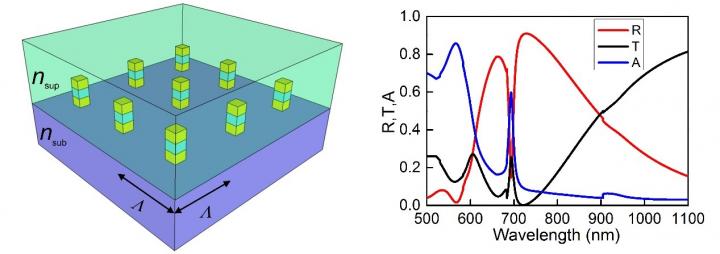Plasmonic nanostructures have been widely used for enhancing light-matter interactions due to the strong local field enhancement in deep subwavelength volumes.
Localized surface plasmon resonances (LSPRs) and propagating surface plasmon resonances (SPR) both suffer from low quality factors and limited field enhancements, resulting in restricted performance in applications. By patterning metal nanoparticles in arrays, plasmonic surface lattice resonances (SLRs) can have lower radiation loss, higher quality factors, and larger field enhancements over large volumes.
A research group led by Dr. LI Guangyuan and Dr. LU Yuanfu from the Shenzhen Institutes of Advanced Technology (SIAT) of the Chinese Academy of Sciences reported a novel type of SLR based on metal-insulator-metal (MIM) arrays. The paper, entitled “Narrow plasmonic surface lattice resonances with preference to asymmetric dielectric environment,” was published on Sep. 2 in Optics Express and was highlighted as an Editor’s Pick.

Conventional SLRs are supported mainly by periodic metal nanoparticles and require a symmetric dielectric environment, that is, the superstrate and the substrate should have the same refractive index. If the dielectric environment becomes less symmetric, SLR performance deteriorates dramatically. This greatly hinders the practical applications of SLRs especially in optofluidic sensors, where it is difficult to match the refractive index of the substrate with water or other fluids.
In this work, the researchers proposed a new SLR supported by a periodic MIM array and with a higher quality factor in a less symmetric dielectric environment. They showed that when the dielectric environment was as asymmetric as the air/glass environment, the proposed SLRhad a high quality factor of 62 under normal incidence and 147 under oblique incidence in the visible regime, or several times the highest quality factors of conventional SLRs under the same conditions.
They also illustrated that an opto-microfluid sensing platform based on the proposed SLR under normal incidence (without optimization) had a sensitivity of 316 nm/RIU and a figure of merit (FOM) of 25. This FOM is much larger than that of conventional LSPR, SPR or SLR sensors.
The researchers believe that the SLR they have proposed, featuring higher quality factors in a less symmetric environment, is appealing for diverse applications, including nanolasers, nonlinear optics, ultrasensitive sensing, and modulators.